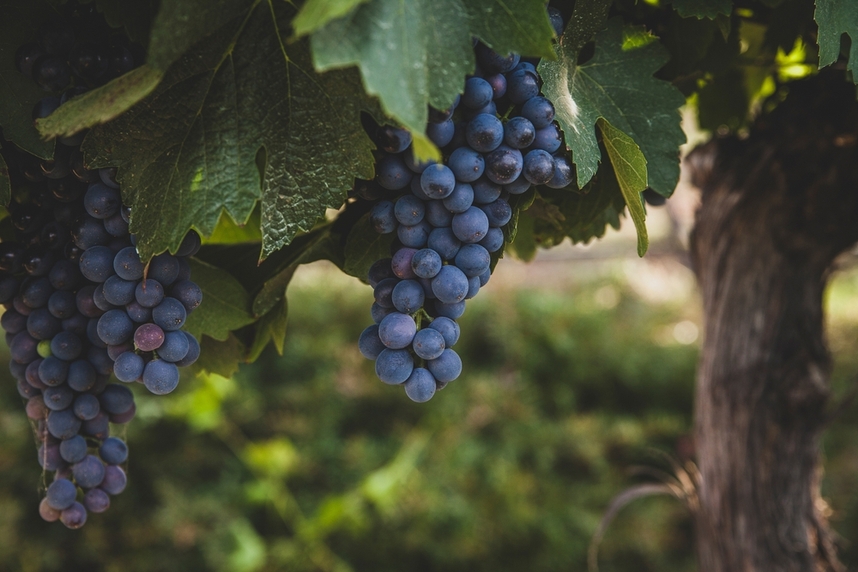In Italy, it is one of the best known representatives of the Sicilian wine tradition, but Syrah (also known as Shiraz) has found a home in various parts of the world, probably starting in France, and then arriving in Australia, South Africa, South America and the United States. It is therefore difficult to describe this grape variety and its wines without taking a trip around the world: here is a guide to the history, characteristics and gastronomic pairings of Syrah wine!
History of a powerful and versatile wine
Telling the story of Syrah wine in a straightforward manner is a complex undertaking, due to its origins being shrouded in myth and disputed between different countries. Some theories mistakenly place the origins of this vine in Syracuse, Sicily, and others in Shiraz, in ancient Persia, but some research conducted on the vine's DNA in the late 1990s clarified many doubts. Syrah, in fact, officially derives from a cross (at an unidentified time) between the French grape varieties Mondeuse Blanche and Dureza, once widespread in the northern Rhône region, from where this international vine was exported all over the world.
It is speculated that it reached the area through importation by the Persians, or that it was the Greek Phocian people who brought it to Marseilles, where it then spread to the rest of the world. It is also said that it was particularly prized by Cleopatra, that Marcus Aurelius Probus in the 3rd century imported it first to Syracuse and then to Gaul, and that Pliny the Elder referred precisely to Syrah when he mentioned a certain allobrogynous vine in his Naturalis Historia. Yet another legend attributes the introduction of the plant into the Rhone after the Holy Wars to the Crusaders.
In Italy, it spread particularly in Tuscany, where it was used to improve the vinification of Chianti, and its name first appears in documents from the first half of the 19th century. The grape variety was then imported from France to Australia in 1821 by the Scotsman James Busby (and only later to the rest of the world), and here it enjoyed great fortune, developing an identity of its own and becoming - under the name Shiraz - the country's most important red grape.
Syrah vs. Shiraz: name curiosities and producer countries

The double spelling by which this wine is called only partly depends on the name by which it is known in the different wine producing countries. The differences between Syrah and Shiraz are mainly due to the style of vinification.
The so-called 'Old World' style is the one typically chosen by Italy and France for the production of Syrah, elegant and characterised by earthy and herbaceous tones, with an undertone of spices often present and pronounced tannins.
According to the 'New World' style generally used for the production of the non-European version of this wine, it is the fruity notes that are emphasised, along with good structure, body and soft tannins.
The most important players in the production of this wine are:
- Europe: In France - its official country of origin - it is mainly produced in the Rhone Valley, while in Italy it has found a particularly cosy home in Sicily, where it is used in blends with Nero d'Avola. Other production areas are Tuscany, Latium, Apulia and Piedmont. Italian Syrah is vinified in the 'Old World' style, resulting in a light structure, herbaceous, earthy and peppery hints, with natural differences depending on terroir and label.
- Australia: under the name Shiraz, it is cultivated in several wine areas, such as the Barossa Valley, McLaren Vale and Coonawarra. Depending on the terroir, this Syrah takes on different organoleptic characteristics, but the 'New World' style focuses mainly on fruity aromas, good structure, slight acidity and a spicy, peppery undertone.
- United States: first appearing in California in the 1970s, today this wine is mainly produced in Paso Robles, Napa, Sonoma, Columbia Valley and Santa Barbara, and is usually mentioned with the Syrah variant. In terms of aromas, it resembles the Australian version more than the European one, presenting more fruity and spicy notes.
- South America: a large part of Syrah cultivation is also concentrated in the states of Chile and Argentina (as well as Brazil and Uruguay), taking on characteristics that change depending on the area of origin. Cool areas of Chile give acidity and hints of black olives, warmer areas push on black fruit tones, while mountainous areas add spice. In Argentina, Syrah red wines are very similar to Australian ones, fruity and full-bodied, a little more spicy in the higher altitude areas.
- South Africa: the rather warm climatic conditions that characterise the terroir of this area are reflected in the organoleptic notes of this Shiraz, which focus on rather pronounced fruity tones - especially black fruits - and pronounced tannins, but balanced by good acidity. There are also hints of pepper and spices.
3 Syrah wines to try and match
Having explored the characteristics of Syrah/Shiraz wine on the different continents, there is no better way to deepen one's knowledge of these wines than through ad hoc proposals.
1. Syrah Terre Siciliane IGT
Although it is part of the production panorama of most of Italy, it is mainly in Sicily that this wine finds its favoured area, giving rise to excellent labels.
It is therefore natural to open this review of the best Syrah wines with a Syrah Terre Siciliane IGT.
The purplish-red colour is only the first of the elegant traits of this wine, which conquers the nose with aromas of ripe fruit, evolving into blackberry notes on the palate.
The full-bodied, elegant sip makes it an excellent companion for many dishes, from savoury first courses to meaty main courses and cured meat appetisers.
The ideal temperature for Sicilian Syrah is between 18° and 20°C. The pairings between Syrah and Mediterranean or Sicilian cuisine are perfect: a full-bodied pasta alla norma, anelletti al forno alla palermitana, involtini alla siciliana or a plate of falsomagro, or a full-bodied mixed board with black pork salami or Sicilian soppressata.
2. Shiraz Cabernet Koonunga Hill '76'
A glass of Shiraz Cabernet Koonunga Hill '76' is a must-try wine if you want to learn more about the Australian style. The warm, sunny terroir and maturation in oak barrels have resulted in a product that is the most authentic expression of international Syrah.
Characterised by a bright red colour, the nose shows the same liveliness, with intense hints of dark fruit and plums and a captivating undertone of chocolate, wood and spices. The result is an elegant and harmonious profile, which captivates the palate with its intense tannins and good acidity.
Excellent for ageing in the cellar, the best matches with Syrah wine (served chilled at around 14°C) are with game, such as tagliatelle with wild boar ragout, barbecued pheasant breast, polenta and venison or roast quail, whose intense and pungent flavours are well supported by the grit of this wine.
3. "Meerestein' Shiraz-Mourvèdre
Finally, this review of international Syrah and Shiraz is closed by a South African wine, the 'Meerestein' Shiraz-Mourvèdre. Produced in the Western Cape area, lashed by ocean breezes, this product conquers the senses with special notes that differentiate it from the varieties already on offer.
There is of course no shortage of red fruit and spices typical of the 'New World' style that characterises most international Syrahs, but a touch of originality is given by vegetal notes that make it all the more interesting. On the palate, the tannins are moderate and the slight acidity helps to refresh the palate.
This Syrah also goes well with meat pairings (even better at a serving temperature of 18°C), which is why you can range without any problems. For a Sunday lunch you can uncork it with a classic roast pork with potatoes, or with a tasty grilled steak, but it is also excellent for a carefree evening of beef burger sandwiches.
Have you chosen your favourite Syrah? If you are still in the grip of indecision, clear your head by browsing the Giordano Vini catalogue!
 Free Delivery from 69£
Free Delivery from 69£
